You had in mind the «fertile Palestine» when you chose green, as you have mentioned before. Were there other instances with similar communication problems.
One problem was that
the posters had to be designed to be posted in the camps, in its narrow
alleys, in Palestinian homes. But they were also to be used for information
campaigns abroad. You had to compromise with regard to using symbols as
well as with regard to the text. Lets have a look at the symbols: on one
of the posters I have drawn a wall with a whole in it in the form of Palestine.
My non-palestinian comrades didn't understand the hint at first sight,
but when I asked a fifty year old Palestinian (he later was murdered in
the massacre of Sabra and Shatila), who couldn't read or write and was
guarding the office, he immediately said with pride, «Falestin».
On the other hand some of the Palestinians had difficulties to understand
wide angled perspectives. For my work the use of perspectives provided
me with the possibility to cope with the manifold demands I had to put
up with. I tried to match this problem with a closer realism. I believe
the difficulty to perceive strong perspectives has got something to do
with the absence of three-dimensional representations in Islamic culture
and by this with a stronger development of two-dimensional ornamental
representations and writing. Especially calligraphy plays a very important
role and even nowadays most of the titles and leads of newspapers are
not set in type but written by a calligrapher. This lettering is of course
of a much better quality than the often clumsy printing types. For my
posters I was working closely with a calligrapher who was working for
the «AI Hadaf» newspaper. I learned a lot from him. Some of the lettering
I did myself. But it took me ten times as long as when he would have done
it.
Did you yourself bring the original to the printer and was the printing done as a routine more or less as you wished, or did you have the possibility to be present during the printing process?
It was not done just
having finished a nice drawing and then placing some sort of a text somewhere
on the paper which then got printed somehow. The poster had to be good
as a print not only as a rough draught. I put very much stress on the
cooperation with the printers. At the beginning this was difficult because
of communication problems. My Arabic was not that good at first and the
workers in the printing shops or the repro-photographers didn't speak
any foreign languages. Very often their shops were also in the «hot» districts
close to the «Green Line», which divided East from West Beirut. The chiefs
didn't like to let me go there alone. It took me some time to find out
how to handle these difficulties.
I always felt happy working with the printers or the repro-photographers.
When we printed colour by colour, instead of four-colour printing in one
go, I was always there and helped mixing the colours. Often I painted
or glued proof sheets directly on the films at the reprographers. It was
of course a lot cheaper when I did it myself. As well as not doing four-colour
printing, because we were in constant lack of money. For example we might
have a look at the poster representing the Palestinian friendship with
Cuba: the Cuban man waving his hat.
You were not tied to your office then, to a world of functionaries, who were only responsible for a small segment of the common cause but screened off from the rest of the world, screened off as well from the entanglements but also from the soberness of the «common» people. They usually feel less and less responsible for the progress of the cause.
Shutting out the
division of labour was perhaps the most fascinating thing:
being in control of the whole process of production. The technical result,
reached by simple means, always gave me great satisfaction. (Printing
technology in countries of the periphery (Trikont) can not by any means
be compared to the one in the centres). This challenge was very tedious
in the beginning. But later on I got to like it all the more. I liked
working best being in my own room where I had a drawing board and good
lights. Very often there were blackouts. So I loved to work during daytime,
especially in the early morning hours. Whenever I had to work during the
night I had a kerosene lamp which gave quite good light in case of blackouts.
In winter this was of no problem, the more so in summer when it was hot
already and the lamp added to the heat.
Have you also been helping with the distribution of the posters?
The posters were posted by the Palestinian Youth Organisation called «Shabiba». In the Shabiba the young people of the camps met to discuss or to educate themselves further. They organized football games, chess or ping-pong tournaments. They also had a musical and a singing group, as well as a Dabka dancing group and a brass band. All activities were meant to cherish the cultural heritage of the Palestinians. Many fighters and cadres of the Palestinian resistance were recruited from the Shabiba. And I almost forgot to mention it: the Shabiba also organized painting and drawing courses, and exhibitions. This was always done in close cooperation with the graphic artists. A lot of the feedback to my posters, which was very important to me, came through people organized in the Shabiba.
In our correspondence you have been using the male gender of the german term for artist. You have done quite many posters for organizations of women, which would be rather out of the question in Western European centres. Are there no female graphic artists ?
There was no woman designing posters. There were only a few men anyhow. This might have been the result of the absence of figurative representation in Islamic culture lasting for ages.
One of the most beautiful posters of this kind is the one you did for the second congress of the Union of Palestinian Women. We can see the back of a woman carrying a basket on her head which is filled with stones instead of fruit. She is standing in front of the silhouette of Jerusalem. The traditional role of the woman as the beast of burden and the bread winner of the fighters is subversively turned around - but it is still her who is providing fresh supplies. Also the beauty of the details on her clothes are very impressive. Couldn't this as well consolidate traditional gender roles: women are represented through their appearance, men as being fighters (Kuffiya)?
I didn't have in
mind the provision of supplies but I wished to show a Palestinian woman
collecting stones as ammunition for herself. The embroidery on the clothing
is a very important symbol for Palestinian women, which in graphic terms
fulfills the need of simple representation. The Kuffiya is in fact not
a representative symbol of the women, but only women under arms carry
it. Embroidered clothing is common among the women of the camps. The Women's
Union itself was always asking me to use it as a symbol. Besides, the
poster was especially designed for Palestinian women who should recognize
themselves. Adversecriticism shows a too narrow point of view of the European
centres.
I wish to know your opinion on the discussion going on in Europe about
«leftist anti-semitism». It sais that the Star of David is not just the
symbol of the state of Israel, of Zionism, but it is also the symbol of
the holocaust during World War II.
The Star of David was put by Zionists on the flag of their colonialist
state. For Palestinians it's the flag of land robbers who drove them out
of their homeland. Somehow you've got to name things, why not through
the symbol your enemy uses himself. For instance we've never used the
«menorah» (seven-armed candelabrum) which Palestinians take as a symbol
for Judaism, in contrast to the Star of David which was made the symbol
of Zionism by the Zionists themselves.
Palestinians have always made a very clear distinction between Judaism
and Zionism because they have been moulded in a somewhat peaceful way
into an islamic-christian-jewish community living on the same spot of
land by the British mandate. Anti-semitism - like Zionism - is a typical
European ideology.
Which policy of the Palestinian resistance was the background of your work as graphic artist during the seventies and the eighties?
Most of the Palestinian
refugees live in Arab countries. Because most of them didn't have the
means to travel far, they live in states with a common border to occupied
Palestine, mainly in Jordan, Lebanon and Syria. The relations of the Palestinian
resistance movement to the governments of these three countries and to
Arab governments in general is a long story of mutual mistrust. On the
one hand the movement has got to be present where the Palestinian masses
live. On the other hand Arab governments have always tried to instrumentalize
the Palestinian resistance movement for their own goals. Over all these
years a large section of the movement has learned to work in this field
offerees. Of course this has not always been that easy. The civil war
in 1970 (Black September) that has been started by the regime of Hussein
under guidance of US imperialism led to an open breach with Jordan. Only
through the radical democratic power of the masses towards the end of
the eighties the movement became again present (over 50% of the population
in Jordan are Palestinians).
In Syria there was a complete split from 1973 through 1977 between the
regime and the Palestinian organizations who rejected the planned Middle
East conference in Geneva. The Syrian government had intervened in the
Lebanese civil war on demand of the US administration and took sides with
the Falange movement. Tal al Za'atar became only possible when the Syrians
sealed off the camp from supplies. The Palestinian resistance movement
hasn't got its own printing shops because they can be so easily closed
down and siezed.
Syria had hoped that the US would honour the service it did in Lebanon
between 1973 and 1978 with pressure on Israel. But the Camp-David agreement
with Egypt was due to be signed. Syria had to realize that it had been
decieved. This resulted in a certain radicalization of the Syrian regime
after 1978 which led to friendly and military agreements with the USSR.
The Palestinian movement had to profit from this new situation without
having any illusions on the nature of the regime. A «front of firmness»
was built against US and Israeli plans in which apart from Syria, the
PLO and other Arab states were taking part. As a consequence the Palestinian
resistance became very active in Syria when it was driven out of Lebanon
by the Israeli invasion.
You were forced to leave bombed out Beirut as well and had to retreat to Damascus. How did this change influence your work?
The Syrian regime
continued the attempts to instrumentalize the movement according to the
political situation with more or less pressure. The Syrian secret services
managed to split the Fatah movement and supported Fatah dissident Abu
Mussa (1983). In 1986 they managed to instrumentalize the Shiite Amal
movement in Lebanon which resulted in the war the Amal forces led against
the Palestinian refugee camps of Beirut and Saida.
At this period several offices of the Palestinians were closed by the
Syrian secret service. It became very difficult to produce printed matters
in Syria. Every activity needed a permission which very often was not
granted. Often drafts and layouts were seized by the censors and kept
back, so nothing could be printed abroad as well.
In order to avoid confiscation I had to go downtown Damascus with my posters.
There were the photographers who did snapshots of the tourists with polaroid
cameras. 1 fixed the poster on a wall and let it take by one of these
photographers. Then I sent the pola to the censors. People on street probably
thought I was mad, but what the heck, 1 was in a hurry most of the time
anyway.
The printers as well would not print without a permission. Only few repro-photographers
could be found who would still make films (not plates) without permission
if we promised that the printing would be done abroad. Usually we ordered
two sets of films. One was smuggled into Lebanon where the posters for
Lebanon and Syria were printed. The other one went to a Western country
where the posters for the international campaigns of information and solidarity
were printed.
I can imagine that you had the idea of producing coloured woodcuts because of these difficulties. You were able to avoid censure, which had put the printers and photographers under pressure.
In 1988 the information
unit of the PLO in Tunis ordered a series of posters from the various
artists of the Palestinian resistance movement that should support the
Intifada. I was asked as well. As mentioned above it was very difficult
to bring the originals out of Syria. The risk to loose them was always
there. If this happened to the repro-film you could make a fresh one.
But the information unit wanted to have the original, as repro and print
would be done in Tunis. So I had the idea of trying a three-coloured woodcut.
If one pattern should get lost I could easily make another one. If you
are making woodcuts in Europe you go to a specialized retailer and buy
the material and the tools you need. In Damascus I had to go to the merchants
who sell wood to the carpenters. I had to run around for quite some time
untill I found a good plank of walnut. A carpenter prepared it for me
with a worn-out plane. The next question was: how do I get proper knives?
In Damascus still live some joiners who sell entire sleeping room furniture
with carvings, mostly done in walnut. So I asked one of the joiners where
he used to buy his tools. He gave me the address of a downtown retailer.
But this one didn't sell them any more, because they were made in Germany
and therefore much too expensive. At the end I went to the district with
the toolmakers. There I found a little workshop which still had a remaining
stock of these German knives. But the tools I bought didn't have a handle.
So I had to go to a district at the other end of town where the turners
had their workshops.
In a printing shop I found a worn-out cylinder that once belonged to a
discarded offset printing machine. I also found there printing colours
and paper. The printer would not let me pay for it, but he wished to have
the first good print instead. After one week I had together all I needed
to start woodcutting (topic: hand with stone, Jerusalem). Because the
Syrian government had closed down several offices of the movement it had
become quite crowded at my working place with too many people rushing
in and out. It v^as almost impossible to concentrate on your work. So
I decided to work in my small flat. The printing of 40 through 50 prints
in the format of 50cm x 70cm in one go was not that easy. We hung wires
across the whole room to dry the prints. Also all the furniture was covered
with prints finished already. So we had to sort of wind ourselves through
the place. When you do printing by hand you can't avoid using a lot of
colour. Because the colour we had was offset printing colour, which is
adapted to the paper by the machine in a thin film, it took quite a long
time to dry out with our method. We had to stay up late till this had
happened.
Would there have been the possibility to produce small editions with the technique of woodcutting if the connection to the printers would have been interrupted?
It's a pity that
this was not possible because we did the posters in three colours with
the same block. I first did the carving for the bright colours which we
printed. Then, on the same original, I cut the holes for the second somewhat
darker colour. We printed this on the first print in glazing technique
and so on. Through this technique we achieved different shades of colours
on top of one another. On the original finally remain only the cuts for
the last and darkest colour. That's why this technique is also called
«lost block»-printing.
The whole thing was also a question of costs: you only had one block instead
of three. I also made careful black prints of each colour in order to
make plates for the usual printing of the posters. They were done in colour
by colour printing. Only the poster done in Tunis was printed in four-colour
technique.
But you kept on producing conventional posters?
Yes, in summer 1991
for example I was asked to design a poster against the suppression and
expulsion of the Palestinians from Kuwait. Because the Syrian government
had taken side with the US and its allies in the Gulf war, no Syrian printer
could be found to do the poster. The repro-photographers as well were
very afraid to cooperate. After running around for some time I found this
kind of an eccentric amateur who was working alone and had no employees.
He was ready to do it for a small extra price. It was two o'clock in the
afternoon with everybody in Damascus at Siesta. He had accepted under
the condition that I would fetch the films at four o'clock and pay cash.
He didn't want to have «hot stuff» in his shop for long. Usually he would
have worked on it for two or three days.
Now I had the problem to collect the money at this time of the day with
all the shops and offices closed. But everything went allright in the
end and the poster was printed in Lebanon. This was the last poster designed
for the movement in Syria. Or was it the one for the second congress of
the Palestinian Youth Organization? I'm not quite sure any more. It's
the poster with the sling drawn in such an audacious perspective that
you have the impression of beeing sucked into the poster.
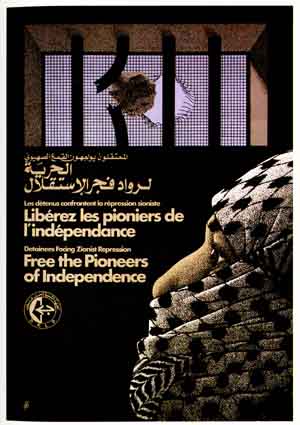
Detainees Facing Zionist Repression -Free the Pioneers of the Independence
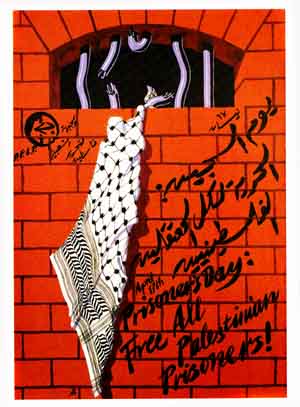
April 17th - Prisoner`s Day - Free All Palestinian Prisoners [May. 1984]
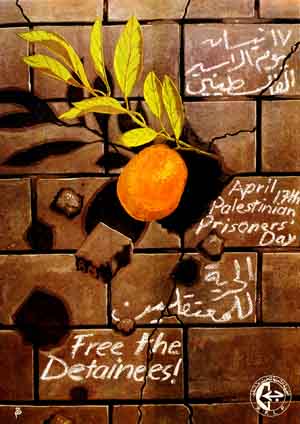
April 17 th - Palestinian Prisoners Day - Free the Detainees
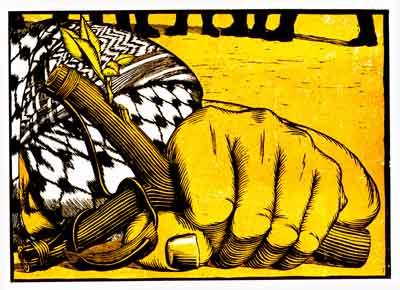
March 9th - Martyr`s Day
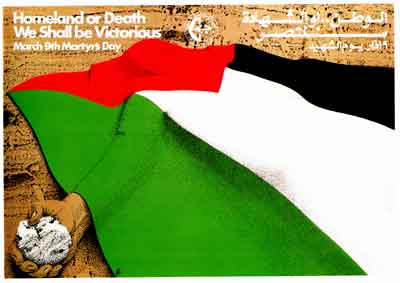
March 9th Matyr`s [March 1988]
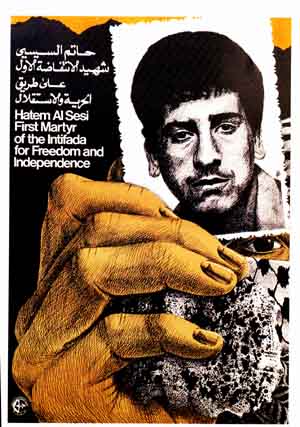
Hatem Al Sesi - First Matyr of the Intifada for Freedom and Indenpence [Dec. 1988]
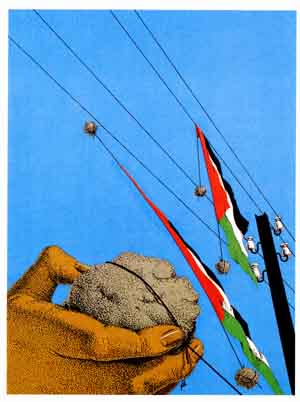
A State is born [Dec. 1988]
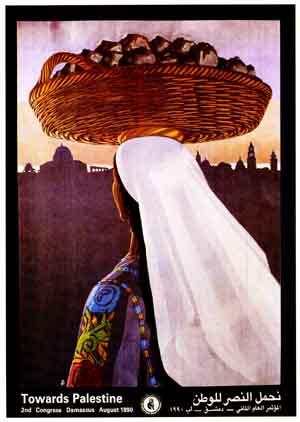
Towards Palestine 2 nd Congress - Damascus August 1990
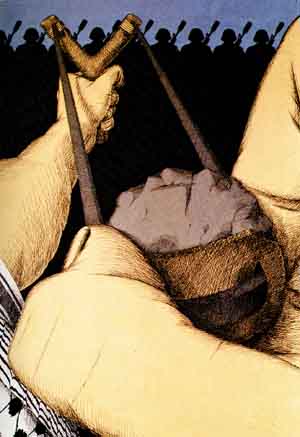
2 nd General Congress - The Congress of the Glorius Intifada - Steadfastness and Confrontation, Damascus August 1991
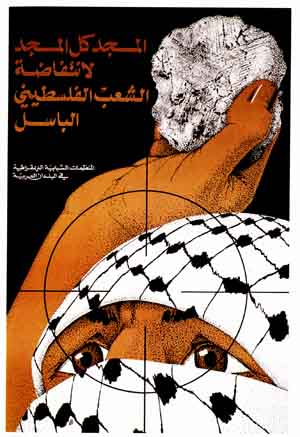
All the Glory to the Intifada of the Courageous People - The Yoouth Organizations in the Arab Countries
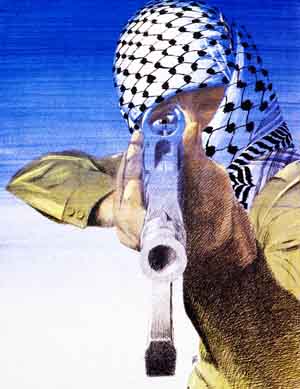
PFLP - 20 Years of Struggle
